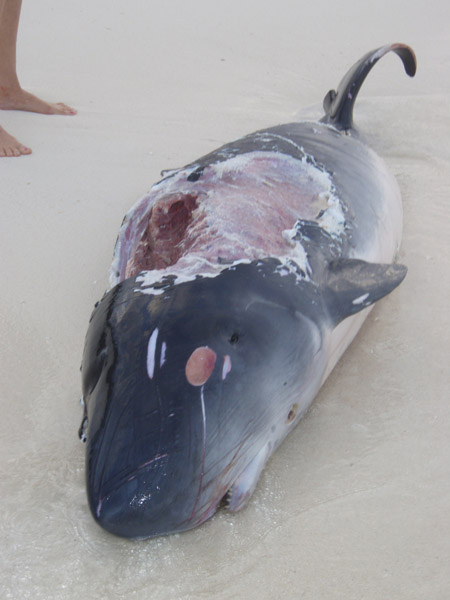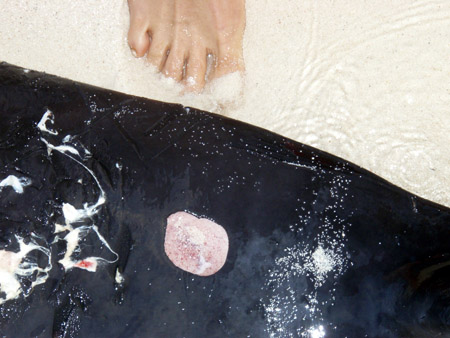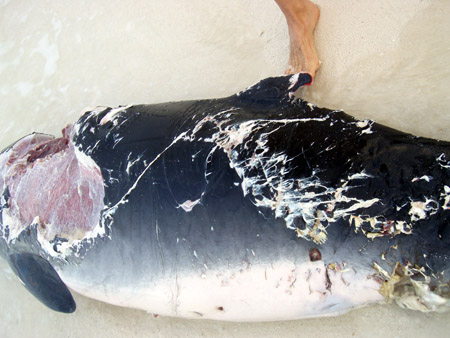Published in the Ocean Watch column, Honolulu Star-Advertiser © Susan Scott
Friday, January 11, 2008
MIDWAY ATOLL » Last week here at Midway, a volunteer found a dead animal he called a cetacean (the scientific name for whales and dolphins) lying on a nearby beach.
“Is it a dolphin?” I asked Craig.
He shrugged. “He just said a cetacean.”
We walked down the beach to see the creature for ourselves. It was, well, a cetacean.
The 7-foot-long animal had bluish-black skin, a roundish head and an underslung lower jaw that seemed too small for its body. Obviously, though, the 26 sharp teeth in that little jaw (no teeth in the upper) did the job. Whatever it was, this cetacean looked well nourished.
Later, biologists with expertise in marine mammals arrived at the scene and identified the creature as a pygmy sperm whale.
Having teeth only in the lower jaw is a distinct characteristic of sperm whales, large and small. A dwarf sperm whale also exists.

I didn’t feel bad about not recognizing the dead whale because pygmy sperm whales are rarely seen. When sightings do occur, it’s when seas are flat and the air is clear. Two or three whales are usually spotted together, floating almost motionless with their snouts barely breaking the surface and their tails hanging down.
If startled while in this basking position, the whale can expel a cloud of reddish-brown feces and dive out of sight. This inking type of behavior might help the whale escape from predators and might also confuse prey.
One report refers to this whale as the firecracker whale due to this explosion of color.
Another reason pygmy sperm whales aren’t spotted often is their blowhole points forward, causing their exhalation spray to shoot ahead rather than up.
Pygmy sperm whales are more oceanic than coastal, and swim in waters throughout the world. Since these whales are so hard to find in the open ocean, biologists get most of their information about them from strandings.
The pygmy sperm whale is the second most commonly stranded cetacean, after the bottlenose dolphin, off the southeastern coast of the United States. It is also found, less often, stranded on West Coast beaches of North America.
But Midway’s whale was no live stranding. This poor creature arrived freshly dead with several kinds of sharks bites on its body. A few Oreo-size bites were made by cookie cutter sharks which clamp, twist and run. These scars aren’t usually fatal.

Another bite on the pygmy sperm whale, however, was big and eye-opening. A large part of the whale’s back muscle was missing, and distinct triangular teeth had punctured the skin of the head.

In the middle of our viewing and discussion, a tiger shark caused some excitement by swimming into shallow water near the beached whale. The shark, we assumed, was interested in recycling the pygmy whale, but on the beach it was out of reach.
Why sharks didn’t eat the dead or gravely injured animal at sea, or inside Midway’s lagoon, is a mystery.
Biologists sent the whale’s stomach to Honolulu for analysis and then buried the carcass in sand.
Now if I ever see a pygmy sperm whale on the beach or at sea, I’ll be able to say a lot more about it than, “It’s a cetacean.”